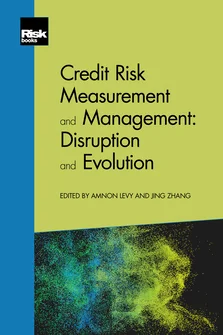Artificial Intelligence and Machine Learning in Credit Risk Analytics: Present, Past and Future
Douglas Dwyer, Tony Hughes and Ashit Talukder
Artificial Intelligence and Machine Learning in Credit Risk Analytics: Present, Past and Future
Foreword
Introduction
An Exploration of the Evolution of Risk: Past, Present and Future
Risk Trading, Risky Debt and Financial Stability
Skating on Thinner Ice: A Macroeconomic Outlook at the End of the Credit Cycle
Climate Change: Managing a New Financial Risk
The Quest to Save Risk-Weighted Assets
The Evolution of the CLO Market since the Global Financial Crisis and a Valuation Approach for CLO Tranches
Homo Ex Machina: Finance Rebooted
Innovation and Digitisation in Credit: A Global Perspective
The Lending Revolution: How Digital Credit Is Changing Banks from the Inside
Digital Lending in Asia: Disruption and Continuity
Digitisation and Automation in Commercial Lending: Disruption without Distraction
Credit Risk Management in the Era of Big Data: From Measurement to Insight
Artificial Intelligence and Machine Learning in Credit Risk Analytics: Present, Past and Future
Integrated Loan Portfolio Modelling and Risk Management
The Role of Banks in Illiquid Credit Markets, and the Disruption and Evolution of Credit Portfolio Management
Epilogue
Algorithms have always played a key role in managing credit risk. Over time, structured data has become bountiful, computer hardware more powerful and software more user-friendly. As a result, the sophistication of algorithms has increased and will continue to increase. Unstructured data has become more accessible, and such information can be analysed using techniques taken from the artificial intelligence (AI) field. In this chapter, we review the state of play for AI and machine learning (ML) in credit risk management, how we arrived there and where we are going. We show that the biggest improvements in credit analytics are likely to arise from using AI and ML to bring new information into risk assessment. Furthermore, whether or not models are intuitive, transparent and reasonable will continue to be important in many (but not necessarily all) aspects of risk analytics.
Lending was active in ancient Greece, and during these ancient times collateral was used to manage credit risk. In the early 1800s, the Rothschilds “created” international banking by establishing an international network for transferring money. From 1816, the Philadelphia Saving Funds Society provided access
Copyright Infopro Digital Limited. All rights reserved.
As outlined in our terms and conditions, https://www.infopro-digital.com/terms-and-conditions/subscriptions/ (point 2.4), printing is limited to a single copy.
If you would like to purchase additional rights please email info@risk.net
Copyright Infopro Digital Limited. All rights reserved.
You may share this content using our article tools. As outlined in our terms and conditions, https://www.infopro-digital.com/terms-and-conditions/subscriptions/ (clause 2.4), an Authorised User may only make one copy of the materials for their own personal use. You must also comply with the restrictions in clause 2.5.
If you would like to purchase additional rights please email info@risk.net











